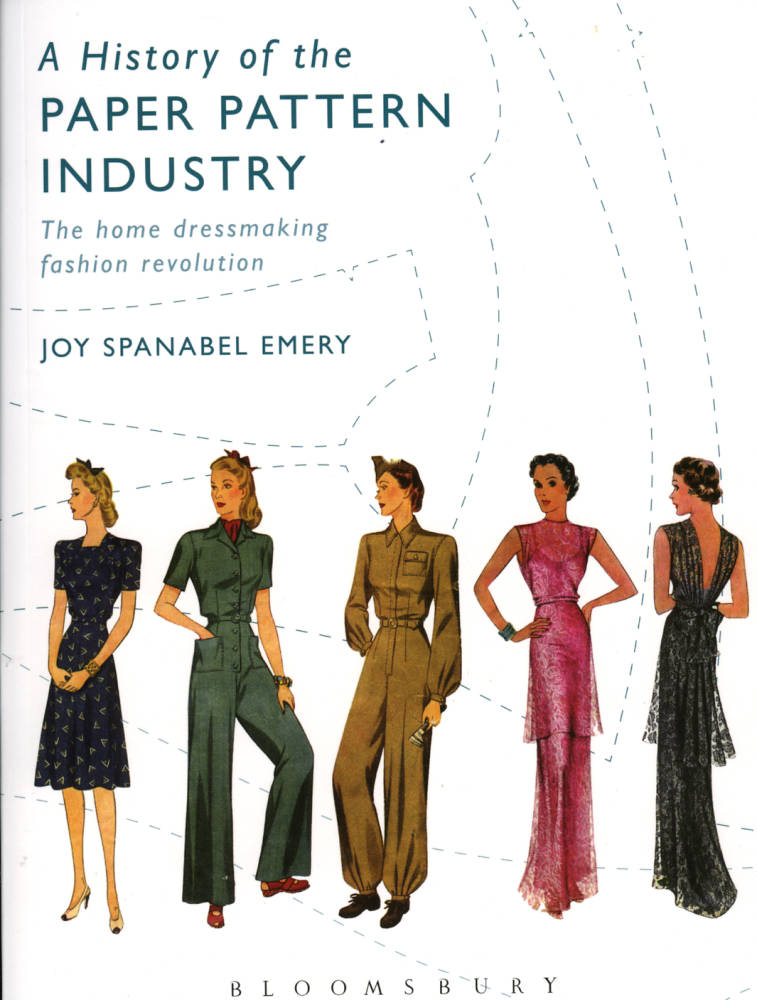[Click on images to enlarge them. Unless otherwise noted, all images come from the book under review. Thackeray created the decorated initial “T” for Vanity Fair — George P. Landow]


hroughout history the three major human industries have been the production of food, shelter, and clothing, so pattern making is neither a trivial nor peripheral activity. Joy Spanabel Emery traces the history of patterns back to the sixteenth century and then moves forward to the present. Her style is clear and straightforward and meant to instruct, a distinct virtue in a volume so full of detail. The book includes ample and appropriate illustrations, placed correctly; an appendix with scalable patterns; and an extensive bibliography. Social historians as well as historians of technology and costume will appreciate the thorough, detailed histories that form the core of each chapter. Although the book probably has most value for those interested in the history of fashion, it will also interest hobbyists, people interested in the economics of specific industries, and social historians.



Left to right: (a) Directions for taking measurements from Scott's Mirror of Fashion (1849). (b) Handbook of Practical Cutting on the Centre point System by John Devere. (c) British Costumes from Tailor and Cutter (1883).
Paper patterns began in 1580 with limited editions meant for the exclusive use of tailors and seamstresses. The goal of the designer of patterns, essential then and still valid, was to use the least fabric to make the desired garment. In the mid-nineteenth century, with the advent of durable, cheap paper, access to postal services and, perhaps most important, the wide use of home sewing machines, that pattern production became a high-volume industry.


Left to right: (a) Block Pattern Advertisement. c. 1897. (b) Illustrations of British Costumes for Autumn and Winter from Tailor and Cutter.
As someone who sews for a hobby, I liked the clear introduction and summary given with each chapter and particularly relished the historical insights scattered throughout. They are tantalizing gems. My favorite comes from the 1851 Godey’s Lady’s Magazine, which advised readers not to consider home dressmaking vulgar. “As an American woman in this era you may be placed in many positions quite…remote. And then what becomes of the helpless?” It would be hard to find such a succinct appeal to self-sufficiency as an opposing force to the traditional hierarchical view of labor. This advice came just a few years before the production of lightweight sewing machines designed for home use. Despite the immensely high cost of such machines (one-fourth of an average yearly income), various schemes, such as shared purchases and slow-payment plans, quickly made sewing machines popular. To overcome the obstacle of cost, there had to have been widespread eagerness to produce clothing quickly and independently at home.


Left to right: (a) Grover, Baker, & Co. Sewing Machine Advertisement from Scott's Mirror of Fashion. (b) Sewing Machine Costume (with a Wheeler & Wison sewing machine) from Butterick Catalogue. c. 1869.
By the 1940s homes had more sewing machines than phones. Clearly the pattern industry’s development was dependent on and parallel to the success of the home sewing machine.


Two images not in the book under review — left to right: (a) A Singer sewing machine decorated with Egyptian motifs from the Acadian Historic Village in West Pubnico, Nova Scotia. (b) Punch on the sewing machine. 1866.
Various factors increased the dissemination of paper patterns: they were marketed through fashion magazines, they offered a variety of sizes, and they offered a wide range of styles for children and adults. By 1900, the pattern industry as we now know it was largely in place, with a few dominant companies and names we still recognize, such as Butterick, Vogue, and McCalls.
Another factor that increased the use of patterns was the educational value they provided when publishers added instructions to the patterns. Printed patterns replaced punched patterns. Although printed patterns were not necessarily more accurate, they were easier to understand and so further increased the industry. Publishers produced books intended for self-instruction. With the rise of education for women, women’s colleges introduced home economics courses, and these offerings included instruction in sewing. Subsequently these courses became standard in public schools. (I learned to read and use patterns in the sewing course required for girls in Junior High School. The knowledge was there when, over ten years later, I wanted to make a silk blouse.)
Major historical events such as World War I, the depression, and World War II had an impact on pattern production. As with the earliest patterns, conservation of fabric was a primary goal. Changing styles, as well as major events, all had an impact. Ease and speed became more and more important. Women working outside the home, simpler styles, and less expensive clothing in stores, all led to the shift in home sewing from the practical task it served for more than 150 years to the role it plays today — primarily serving people who sew for pleasure.
Bibliography
Emery, Joy Spanabel. A History of the Paper Pattern Industry: The home Dressmaking Fashion Revolution. London and New York: Bloomsbury, 2014. ISBN PB:97 8-0-8578-5831-3. Pp. 240.
Last modified 6 August 20142